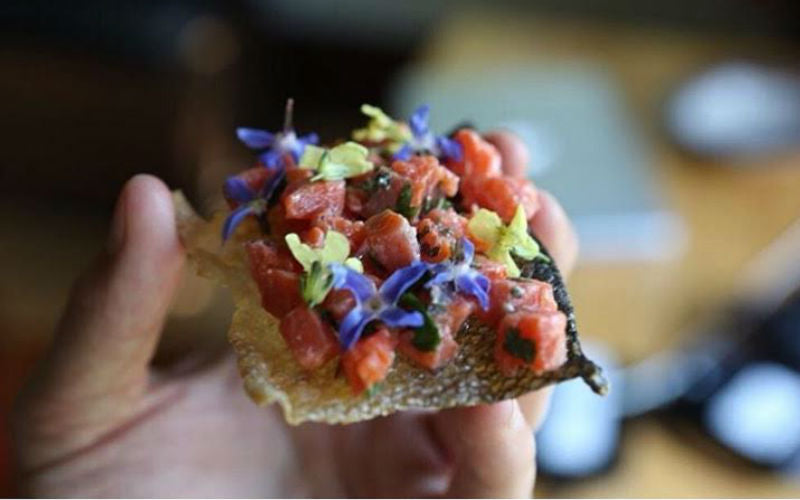May 09, 2018 1 Comment

Originally posted by Beka Thoning with the impressive Alaska Stillpoint Lodge in Halibut Cove, Alaska. If you're looking for an unforgettable Alaskan getaway for your family or business, check out this majestic lodge. Their service and food is amazing; they purchase their seafood from us and other local fishermen.

Alaskan artists dedicate entire exhibits to its ocean-fresh, silvery-blue patterns. I wear locally-made earrings with embedded salmon skin jewels. We cure and tan it and make salmon skin leather wallets and baby slippers and bustiers. We even see the Alaskan coastal brown bear ripping off the skin of a salmon (his favorite part) and leaving the rest behind. That's not just because he likes the taste. The majority of those healthy omega-3 fats are stored within the salmon's skin.
Just like the brown bear- Alaskan humans LOVE eating salmon skin. An expertly grilled fillet of salmon has some sexy, smokey-charred grill marks, moist and flaky flesh, and sizzling, crispy skin. We often even serve it skin side up so it won't get soggy on the plate. My daughter loves peeling the skin off a pan-seared king salmon filet, then returning it, salted and flat, right back into the cast iron skillet to fry in its own oils like a clandestine chicharrón. <<Crunch>> So good! The scales are so soft and small that you can't even detect them. Chop it up like bacon bits in your salad. My personal favorite is thin strips of crispy salmon skin wrapped up in a Nori sushi roll and dipped in wasabi creme.
It breaks my heart to think about all the wasted wild Alaska salmon skin. I cringe when I see a happy customer's empty plate, licked clean... a perfect piece of salmon skin the only thing remaining. At the lodge, any scraps go into the chicken bucket, so nothing is really wasted. And I know many a home cook shares their discarded salmon skin with their beloved pets... but for a fact many too many beautiful pieces of salmon skin end up in the trash. In the landfill.
Why?
Maybe several reasons...
However, when you opt for wild-caught, sustainable Alaska salmon there are significantly fewer toxins than in farmed salmon.
Let's talk about not wasting wild Alaska salmon skin.
Too many times I've seen a recipe that reads something like this... "8 oz. filet of sockeye salmon, deboned, discard skin". Discard?! No way! So I set out to figure out how to utilize salmon skin -- and not just by way of me frying it and shoving it into my mouth while hovering over the stove -- but more strategically.
One thing that I found is salmon skin can add beneficial binding power and moisture to my favorite salmon cake recipe... making them Perfect Salmon Cakes. Check out my recipe and the secret technique... and please eat those wild Alaska salmon skins!

Beka Thoning, Alaska Stillpoint Lodge

By Beka Thoning, Alaska Stillpoint Lodge
Minimum 2 hours prep time. Chilled ingredients form better cakes!
Yield: 20 cakes, easily doubled
Preheat oven to 350° F.
In an oven proof pan, place salmon skin side down. Brush with olive oil and sprinkle with salt and pepper. Roast for 10 to 15 minutes, until just cooked then remove from the oven and cover with a tight-fitting lid. Allow to rest for 10 minutes and refrigerate until cold.
In another pan on the stovetop, combine butter, olive oil, onion, celery, capers, seasoning, salt and pepper over medium heat stirring occasionally until the vegetables are soft, approximately 10 minutes. Stir in sun-dried tomatoes and parsley and cook another 5 minutes. Remove from heat and allow mixture to cool to room temperature.
Flake the chilled salmon into a large bowl, remove bones and reserve skin. Combine the salmon skin, mayonnaise, mustard, and eggs in a blender on high speed until smooth, then pour into the bowl with the flaked salmon. Mix in 1 cup of the bread crumbs and the cooled vegetable mixture and stir well to combine. Once again, refrigerate for 30 minutes or overnight. Shape into 20 (1.5-ounce) patties, and coat in remaining bread crumbs. (Can freeze individually on a sheet pan at this stage)
In a large cast iron skillet, heat another 2 tablespoons butter and 2 tablespoons olive oil over medium heat. Add the croquettes in batches and brown for 3 minutes on each side. To keep them warm, place a cooling rack on a sheet pan in a 200° F preheated oven, and transfer the batches onto the rack as they come out of the skillet.
Serve hot with lemon, dill and garlic aioli.
(Feel free to substitute Vegenaise and/or gluten-free bread crumbs... both work fine.)
Mix together and store in airtight container.
Blog cover photo originally posted by @griermountain
Comments will be approved before showing up.
October 01, 2025
Order now for the freshest fish of the year! Our preorders have shipped, but we have plenty of wild Alaska sockeye salmon in stock now to fill your freezers.
August 15, 2025
The F/V Courageous is on blocks until next season, and we're busy adventuring, harvesting, and packing a whole summer into three weeks.
Emma Cook
November 23, 2019
I agree that the skin is a terrible thing to waste! :P